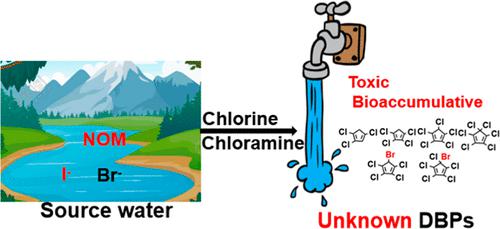当前位置:
X-MOL 学术
›
Environ. Sci. Technol.
›
论文详情
Our official English website, www.x-mol.net, welcomes your
feedback! (Note: you will need to create a separate account there.)
Halocyclopentadienes: An Emerging Class of Toxic DBPs in Chlor(am)inated Drinking Water
Environmental Science & Technology ( IF 10.8 ) Pub Date : 2022-08-08 , DOI: 10.1021/acs.est.2c02490 Jiafu Li 1, 2 , Md Tareq Aziz 1 , Caroline O Granger 1 , Susan D Richardson 1
Environmental Science & Technology ( IF 10.8 ) Pub Date : 2022-08-08 , DOI: 10.1021/acs.est.2c02490 Jiafu Li 1, 2 , Md Tareq Aziz 1 , Caroline O Granger 1 , Susan D Richardson 1
Affiliation

|
Although >700 disinfection by-products (DBPs) have been identified to date, most DBPs in drinking water are still unknown. Identifying unknown DBPs is an important step for improving drinking water quality because known DBPs do not fully account for the adverse health effects noted in epidemiologic studies. Using gas chromatography high-resolution mass spectrometry, six chloro- and bromo-halocyclopentadienes (HCPDs) were identified in chlorinated and chloraminated drinking water via non-target analysis; five HCPDs are reported for the first time as new alicyclic DBPs. Formation pathways were also proposed. Simulated disinfection experiments with Suwannee River natural organic matter (NOM) confirm that NOM is a precursor for these new DBPs. Further, HCPDs are more abundant in chlorinated drinking water (real and simulated) when compared to chloraminated drinking water due to the higher reactivity of chlorine. Of these new DBPs, 1,2,3,4,5,5-hexachloro-1,3-cyclopentadiene is approximately 100,000× more toxic (in vivo) than regulated trihalomethanes (THMs) and haloacetic acids (HAAs) and 20–2000× more toxic than halobenzoquinones, halophenols, and halogenated pyridinols using the available median lethal dose (LD50) and concentration for 50% of maximal effective concentration (EC50) of DBPs to aquatic organisms. The predicted bioconcentration factors of these HCPDs range from 384 to 3980, which are 2–3 orders of magnitude higher than those for regulated and priority DBPs (including THMs, HAAs, halobenzoquinones, haloacetonitriles, haloacetamides, halonitromethanes, haloacetaldehydes, iodo-THMs, and iodo-HAAs). Thus, HCPDs are an important emerging class of DBPs that should be studied to better understand their impact on drinking water quality and long-term human health exposure.
中文翻译:

卤代环戊二烯:氯化饮用水中一类新兴的有毒 DBP
尽管迄今为止已发现超过 700 种消毒副产物 (DBP),但饮用水中的大多数 DBP 仍然未知。识别未知的 DBP 是改善饮用水质量的重要一步,因为已知的 DBP 并不能完全解释流行病学研究中指出的不利健康影响。使用气相色谱高分辨率质谱法,通过非目标分析在氯化和氯胺化饮用水中鉴定出六种氯代和溴代卤代环戊二烯(HCPD);首次报道了五种 HCPD 作为新的脂环族 DBP。还提出了形成途径。苏万尼河天然有机物 (NOM) 的模拟消毒实验证实,NOM 是这些新 DBP 的前体。此外,由于氯的反应性较高,与氯胺饮用水相比,氯胺饮用水(真实的和模拟的)中的 HCPD 含量更丰富。在这些新的 DBP 中,1,2,3,4,5,5-六氯-1,3-环戊二烯的毒性(体内)比受管制的三卤甲烷 (THM) 和卤乙酸 (HAAs) 大约高 100,000 倍,并且 20-2000 × 使用 DBP 对水生生物的可用半数致死剂量 (LD 50 ) 和最大有效浓度 (EC 50 ) 50% 的浓度,比卤代苯醌、卤代酚和卤代吡啶酚更具毒性。这些 HCPD 的预测生物浓度系数范围为 384 至 3980,比受管制和优先的 DBP(包括 THM、HAA、卤代苯醌、卤代乙腈、卤代乙酰胺、卤代硝基甲烷、卤代乙醛、碘-THM 和碘-HAA)。 因此,HCPD 是一类重要的新兴 DBP,应该对其进行研究,以更好地了解它们对饮用水质量和人类长期健康暴露的影响。
更新日期:2022-08-08
中文翻译:

卤代环戊二烯:氯化饮用水中一类新兴的有毒 DBP
尽管迄今为止已发现超过 700 种消毒副产物 (DBP),但饮用水中的大多数 DBP 仍然未知。识别未知的 DBP 是改善饮用水质量的重要一步,因为已知的 DBP 并不能完全解释流行病学研究中指出的不利健康影响。使用气相色谱高分辨率质谱法,通过非目标分析在氯化和氯胺化饮用水中鉴定出六种氯代和溴代卤代环戊二烯(HCPD);首次报道了五种 HCPD 作为新的脂环族 DBP。还提出了形成途径。苏万尼河天然有机物 (NOM) 的模拟消毒实验证实,NOM 是这些新 DBP 的前体。此外,由于氯的反应性较高,与氯胺饮用水相比,氯胺饮用水(真实的和模拟的)中的 HCPD 含量更丰富。在这些新的 DBP 中,1,2,3,4,5,5-六氯-1,3-环戊二烯的毒性(体内)比受管制的三卤甲烷 (THM) 和卤乙酸 (HAAs) 大约高 100,000 倍,并且 20-2000 × 使用 DBP 对水生生物的可用半数致死剂量 (LD 50 ) 和最大有效浓度 (EC 50 ) 50% 的浓度,比卤代苯醌、卤代酚和卤代吡啶酚更具毒性。这些 HCPD 的预测生物浓度系数范围为 384 至 3980,比受管制和优先的 DBP(包括 THM、HAA、卤代苯醌、卤代乙腈、卤代乙酰胺、卤代硝基甲烷、卤代乙醛、碘-THM 和碘-HAA)。 因此,HCPD 是一类重要的新兴 DBP,应该对其进行研究,以更好地了解它们对饮用水质量和人类长期健康暴露的影响。











































 京公网安备 11010802027423号
京公网安备 11010802027423号